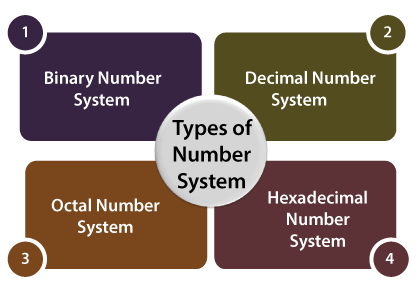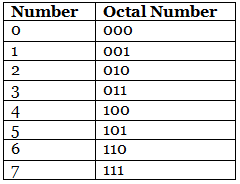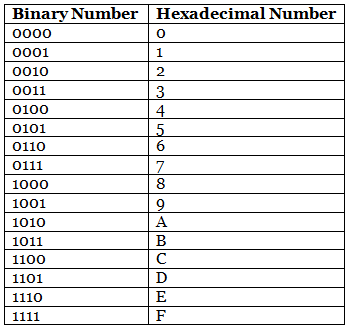GATE Exam > GATE Notes > Number System
Number System - GATE PDF Download
Introduction
- In a digital system, the system can understand only the positional number system.
- In these systems, digit symbols are used to represent different values, depending on the index at which it settled in the number system.
- In simple terms, to represent the information, we use the number system in the digital system.

The digit value in the number system is calculated using:
- The digit
- The index, where the digit is present in the number.
- Finally, the base numbers, the total number of digits available in the number system.
Note: When the number system represents a digit from 0 - 9, the base of the number will be 10.
Types of Number System
In the digital computer, there are various types of number systems used for representing information.

Binary Number System
Generally, a binary number system is used in the digital computers. In this number system, it carries only two digits, either 0 or 1. There are two types of electronic pulses present in a binary number system. The first one is the absence of an electronic pulse representing '0'and second one is the presence of electronic pulse representing '1'. Each digit is known as a bit. A four-bit collection (1101) is known as a nibble, and a collection of eight bits (11001010) is known as a byte. The location of a digit in a binary number represents a specific power of the base (2) of the number system.Characteristics:
- It holds only two values, i.e., either 0 or 1.
- It is also known as the base 2 number system.
- The position of a digit represents the 0 power of the base(2). Example: 2x
- The position of the last digit represents the x power of the base(2). Example: 2x, where x represents the last position, i.e., 1
Examples:
(10100)2, (11011)2, (11001)2, (000101)2, (011010)2.
Decimal Number System
- Decimal numbers are used in our day-to-day life. The decimal number system contains ten digits from 0 to 9(base 10). Here, the successive place value or position, left to the decimal point, holds units, tens, hundreds, thousands, and so on.
- The position in the decimal number system specifies the power of the base (10). The 0 is the minimum value of the digit, and 9 is the maximum value of the digit. For example, the decimal number 2541 consists of the digit 1 in the unit position, 4 in the tens position, 5 in the hundreds position, and 2 in the thousand position, and the value will be written as:
(2 × 1000) + (5 × 100) + (4 × 10) + (1 × 1)
(2 × 103) + (5 × 102) + (4 × 101) + (1 × 100)
2000 + 500 + 40 + 1
2541
Octal Number System
The octal number system has base 8(means it has only eight digits from 0 to 7). There are only eight possible digit values to represent a number. With the help of only three bits, an octal number is represented. Each set of bits has a distinct value between 0 and 7.Below, we have described certain characteristics of the octal number system:
Characteristics:
- An octal number system carries eight digits starting from 0, 1, 2, 3, 4, 5, 6, and 7.
- It is also known as the base 8 number system.
- The position of a digit represents the 0 power of the base(8). Example: 80
- The position of the last digit represents the x power of the base(8). Example: 8x, where x represents the last position, i.e., 1

Examples:
(273)8, (5644)8, (0.5365)8, (1123)8, (1223)8.
Hexadecimal Number System
It is another technique to represent the number in the digital system called the hexadecimal number system. The number system has a base of 16 means there are total 16 symbols(0, 1, 2, 3, 4, 5, 6, 7, 8, 9, A, B, C, D, E, F) used for representing a number. The single-bit representation of decimal values10, 11, 12, 13, 14, and 15 are represented by A, B, C, D, E, and F. Only 4 bits are required for representing a number in a hexadecimal number. Each set of bits has a distinct value between 0 and 15. There are the following characteristics of the octal number system:Characteristics:
- It has ten digits from 0 to 9 and 6 letters from A to F.
- The letters from A to F defines numbers from 10 to 15.
- It is also known as the base 16number system.
- In hexadecimal number, the position of a digit represents the 0 power of the base (16). Example: 160
- In hexadecimal number, the position of the last digit represents the x power of the base(16). Example: 16x, where x represents the last position, i.e., 1

Examples:
(FAC2)16, (564)16, (ABD5)16, (1123)16, (11F3)16.
FAQs on Number System - GATE
| 1. What is the number system in GATE? |  |
Ans. The number system in GATE refers to the representation and manipulation of numbers in various formats, such as binary, decimal, octal, and hexadecimal. It involves understanding the properties and operations of these number systems and their conversions.
| 2. How important is the number system in the GATE exam? |  |
Ans. The number system is a fundamental concept in computer science and engineering. It is highly important in the GATE exam as it forms the basis for understanding various topics like digital logic, computer organization, and computer arithmetic. A strong understanding of the number system is crucial for solving problems in these areas.
| 3. What are the different types of number systems tested in the GATE exam? |  |
Ans. The GATE exam primarily tests knowledge of four number systems: binary, decimal, octal, and hexadecimal. These number systems have different bases and are used in different contexts. Understanding their conversions and properties is important for solving numerical problems in the exam.
| 4. How can I improve my understanding of the number system for the GATE exam? |  |
Ans. To improve your understanding of the number system for the GATE exam, it is essential to practice solving problems related to number system conversions, arithmetic operations, and logical operations. Additionally, studying relevant textbooks and online resources, attending lectures or tutorials, and solving previous year GATE questions can significantly enhance your grasp of the number system.
| 5. Are there any shortcuts or tricks to solve number system problems in the GATE exam? |  |
Ans. Yes, there are certain shortcuts and tricks that can be used to solve number system problems quickly and efficiently in the GATE exam. These include techniques like using pattern recognition, simplifying the problem by eliminating unnecessary steps, and using mental calculations for basic arithmetic operations. Regular practice and familiarity with these tricks can help improve speed and accuracy in solving number system problems.
Related Searches




















